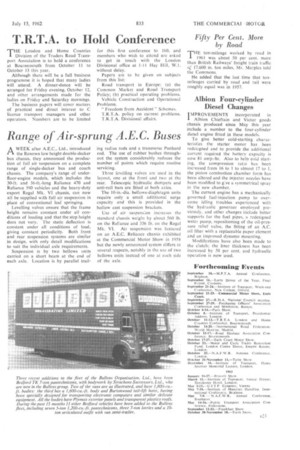Range of Air-sprung A.E.C. Buses
Page 29

If you've noticed an error in this article please click here to report it so we can fix it.
AWEEK after A.E.C., Ltd., introduced the Renown low height double-decker bus chassis, they announced the production of full air suspension on a complete range of single-decker bus and coach chassis. The company's range of underfloor-engine models, which includes the 30-ft. and 36-ft.-long Reliance 470 and Reliance 590 vehicles and the heavy-duty export Regal Mk. VI chassis, can now all be supplied w;th full air suspension in place of conventional leaf springing.
Levelling valves ensure that the frame height remains constant under all conditions of loading and that the step height does not vary. The static deflection is constant under all conditions of load, giving constant periodicity. Both front and rear suspension systems are similar in design, with only detail modifications to suit the individual axle requirements.
Suspension is by two bellows units carried on a short beam at the end of each axle. Location is by parallel trail
ing radius rods and a transverse Panhard rod. The use of rubber bushes throughout the system considerably reduces the number of points which require routine servicing.
Three levelling valves are used in the layout, one at the front and two at the rear. Telescopic hydraulic dampers and anti-roll bars are fitted at both axles.
The 10-in.-dia. bellows-diaphragm units require only a small additional surge capacity and this is provided in the hollow cast suspension brackets.
Use of air suspens;on increases the standard chassis weight by about 560 lb. on the Reliance and 336 lb. on the Regal Mk. VI. Air suspension was featured on an A.E.C. Reliance chassis exhibited at the Commercial Motor Show in 1958 but the newly announced system differs in several respects, notably in the use of two bellows units instead of one at each side of the axle.












































































































